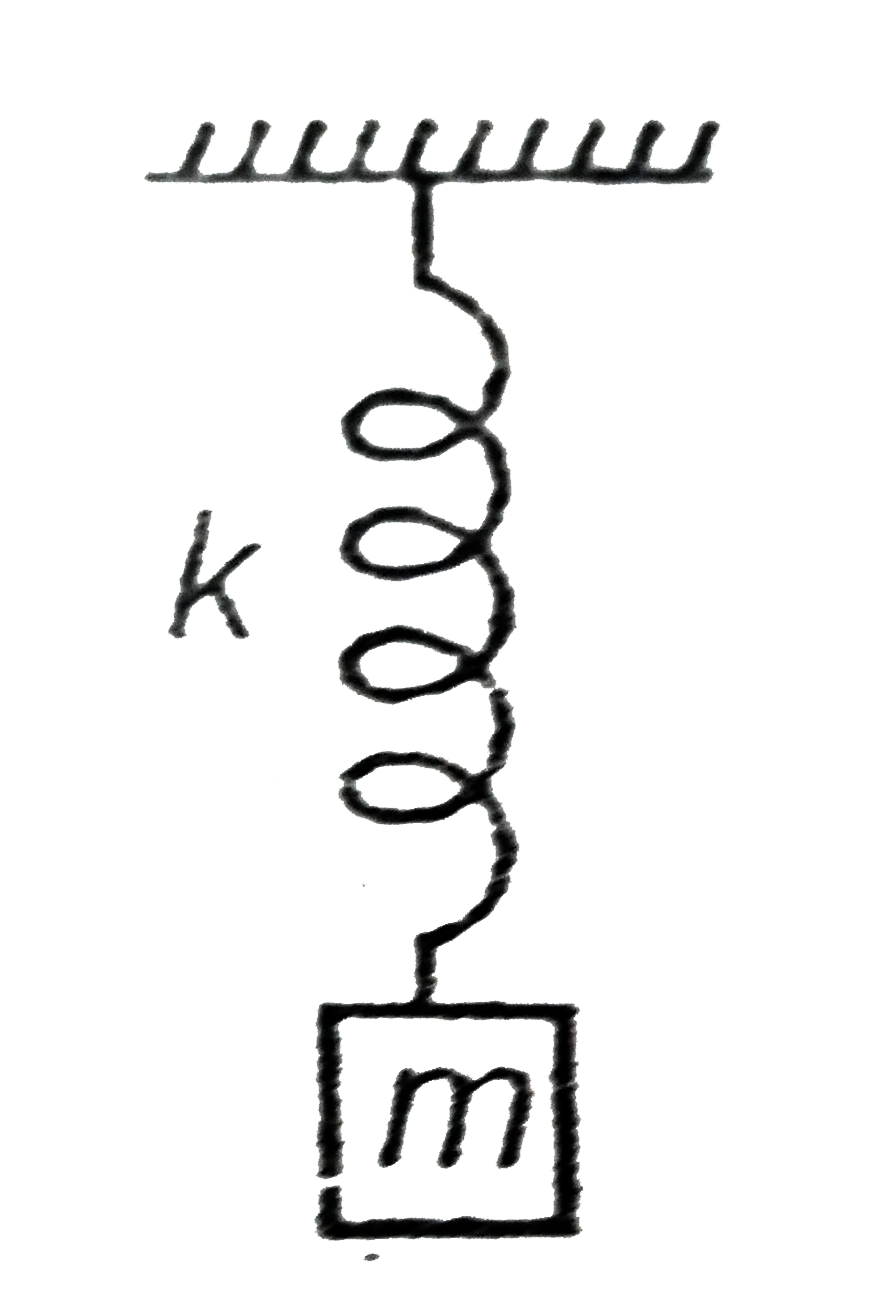A block of 2 kg is suspended from the ceiling through a massless spring of spring constant k=100 N/m. What is the elongation of the spring? If another 1 kg is added to the block, what would be the further elongation?
To solve the problem step by step, we will analyze the forces acting on the spring when the blocks are added and calculate the elongation of the spring in both scenarios.
Step 1: Calculate the elongation of the spring with the 2 kg block
1. Identify the forces acting on the spring:
- The weight of the 2 kg block (W1) acting downwards.
- The spring force (F_spring) acting upwards.
2. Calculate the weight of the 2 kg block:
W1=m1⋅g=2kg⋅9.8m/s2=19.6N
(We can approximate g as 10m/s2 for simplicity, giving W1≈20N).
3. Set up the equilibrium condition:
At equilibrium, the spring force equals the weight of the block:
Fspring=k⋅x1=W1
Where k=100N/m is the spring constant and x1 is the elongation.
4. Substitute the values:
100⋅x1=20
5. Solve for x1:
x1=20100=0.2m
Step 2: Calculate the further elongation when an additional 1 kg block is added
1. Determine the new total mass:
The total mass now is 2kg+1kg=3kg.
2. Calculate the new weight (W2):
W2=m2⋅g=3kg⋅9.8m/s2=29.4N
(Again, approximating g gives W2≈30N).
3. Set up the equilibrium condition for the new weight:
Fspring=k⋅x2=W2
4. Substitute the values:
100⋅x2=30
5. Solve for x2:
x2=30100=0.3m
Step 3: Calculate the further elongation
1. Determine the further elongation:
The further elongation when the 1 kg block is added is:
Further elongation=x2−x1=0.3m−0.2m=0.1m
Final Results
- The elongation of the spring with the 2 kg block is 0.2 m.
- The further elongation when an additional 1 kg is added is 0.1 m.
---
- The weight of the 2 kg block (W1) acting downwards.
- The spring force (F_spring) acting upwards.
W1=m1⋅g=2kg⋅9.8m/s2=19.6N
(We can approximate g as 10m/s2 for simplicity, giving W1≈20N).
At equilibrium, the spring force equals the weight of the block:
Fspring=k⋅x1=W1
Where k=100N/m is the spring constant and x1 is the elongation.
100⋅x1=20
x1=20100=0.2m
The total mass now is 2kg+1kg=3kg.
W2=m2⋅g=3kg⋅9.8m/s2=29.4N
(Again, approximating g gives W2≈30N).
Fspring=k⋅x2=W2
100⋅x2=30
x2=30100=0.3m
The further elongation when the 1 kg block is added is:
Further elongation=x2−x1=0.3m−0.2m=0.1m
- The elongation of the spring with the 2 kg block is 0.2 m.
- The further elongation when an additional 1 kg is added is 0.1 m.
Topper's Solved these Questions
- NEWTON'S LAWS OF MOTIONBOOK - HC VERMA ENGLISHCHAPTER - NEWTON'S LAWS OF MOTIONEXERCISE - Questions for short Answer
17 Videos
- NEWTON'S LAWS OF MOTIONBOOK - HC VERMA ENGLISHCHAPTER - NEWTON'S LAWS OF MOTIONEXERCISE - Objective -2
9 Videos
- LAWS OF THERMODYNAMICSBOOK - HC VERMA ENGLISHCHAPTER - LAWS OF THERMODYNAMICSEXERCISE - All Questions
64 Videos
- PHYSICS AND MATHEMATICSBOOK - HC VERMA ENGLISHCHAPTER - PHYSICS AND MATHEMATICSEXERCISE - Question for short Answer
14 Videos
Similar Questions
The block of mass m is released when the spring was in its natrual length. Spring constant is k. Find the maximum elongation of the spring.

View SolutionA block of mass m suspended from a spring of spring constant k. Find the amplitude of S.H.M.
View SolutionA block of mass m is connected to another .block of mass M by a massless spring of spring constant k. A constant force f starts action as shown in figure, then:

View SolutionA block of mass 2 kg is dropped from a height of 40 cm on a spring whose force-constant 1960Nm−1. The maximum distance through which the spring is compressed by
View SolutionA block of mass m is connect to another block of mass M by a massless spring of spring constant k. The blocks are kept on a smooth horizontal plane. Initially the blocks are at rest and the spring is upstretched when a constant force F starts acting on the block of mass M to pull it. Find the maximum extension of the spring.

View SolutionA block of mass m is connected to another block of mass M by a massless spring of spring constant k. the blocks are kept of a smooth horizontal plane and are at rest. The spring is unstretched when a constant force F starts acting on the block of mass M of pull it. Find the maximum extension of the spring

View SolutionA block of mass m is connect to another block of mass M by a massless spring of spring constant k. The blocks are kept on a smooth horizontal plane. Initially the blocks are at rest and the spring is unsrtretched when a constnt force F starts acting on the block of mass M to pull it. Find the maximum extension of the spring.

View SolutionA block with a mass of 3.00kg is suspended from an ideal spring having negligible mass and stretches the spring by 0.2m.
(a) What is the force constant of the spring?
(b) What is the period of oscillation of the block if it is pulled down and released ?
View SolutionA block with a mass of 3.00kg is suspended from an ideal spring having negligible mass and stretches the spring by 0.2m.
(a) What is the force constant of the spring?
(b) What is the period of oscillation of the block if it is pulled down and released ?
View Solutiona block of mass 0.1 kg attached to a spring of spring constant400Nm pulled horizontally from x=0 tox1=10mm. Find the work done by the spring force
View Solution
